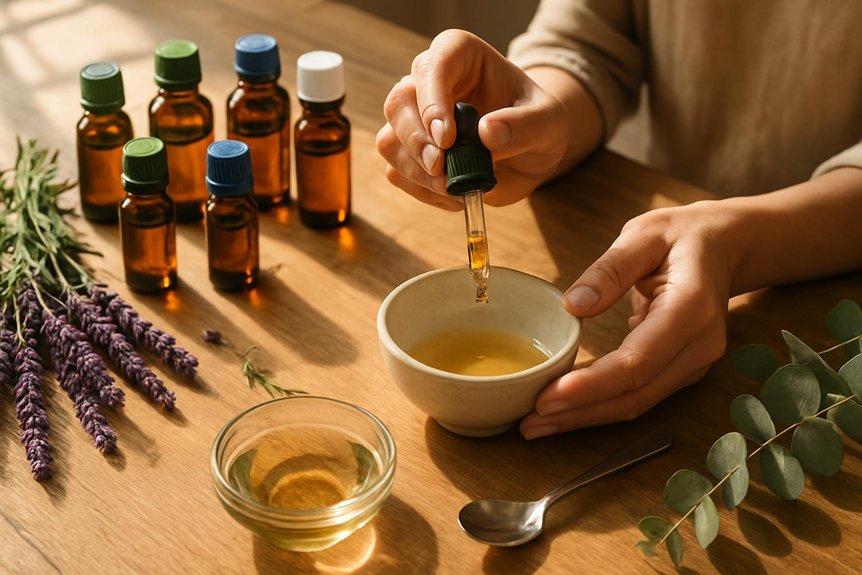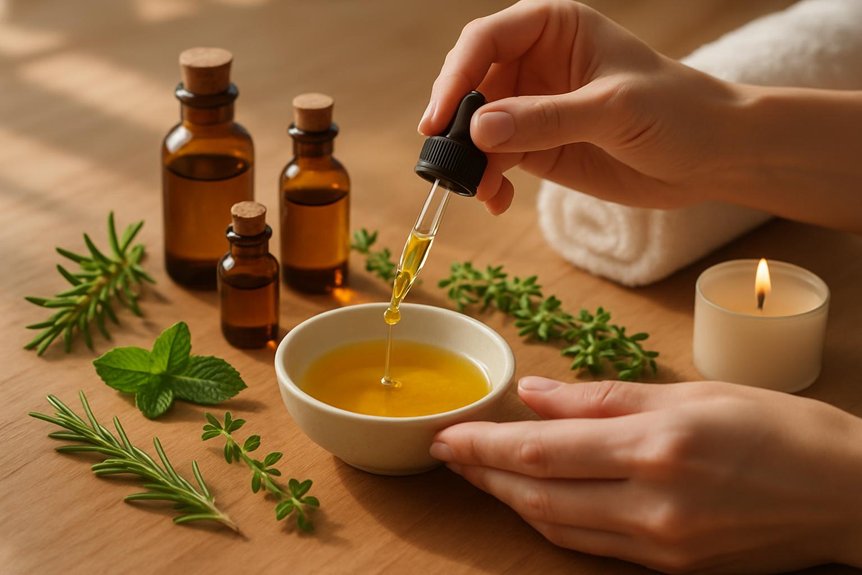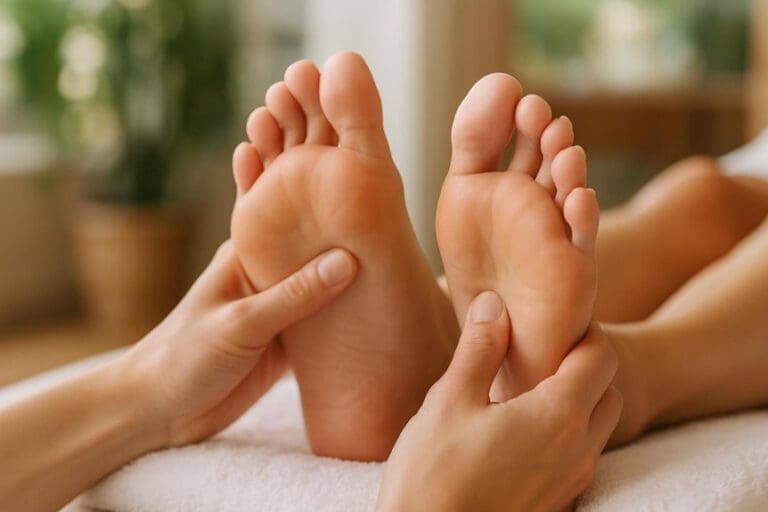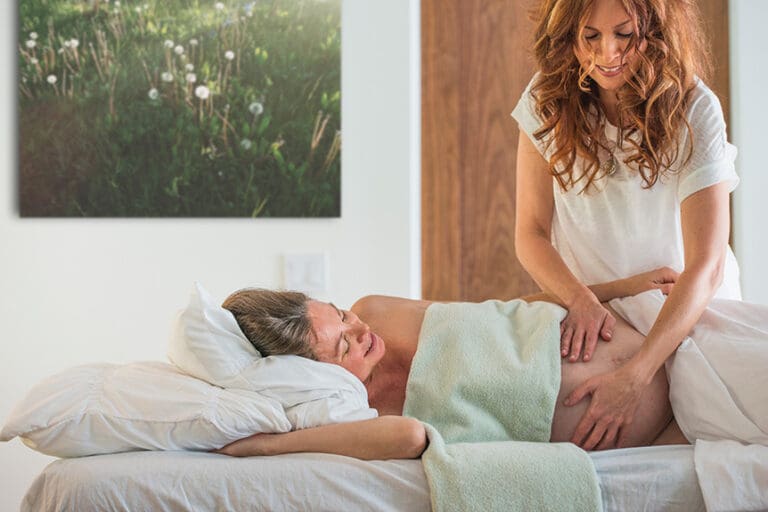To mix aromatherapy oils for massage, choose verified-pure essential oils with known Latin names and low sensitization risk (e.g., lavender, Roman chamomile). Pair with stable carrier oils (fractionated coconut, jojoba). Dilute to 1–2% for full-body (6–12 drops per 30 ml), 0.5–1% for pregnancy or sensitive skin, up to 3% for localized areas. Patch test at 1% and reassess at 30 minutes, 24 and 48 hours. Store in amber glass, cool and dark. Next, see therapist-approved blending steps and goal-based formulas.
Choosing Safe Essential Oils for Massage

A safe essential oil selection begins with clinical considerations: botanical identification (Latin binomial), chemotype when relevant (e.g., CT linalool), verified purity, and appropriate dermal limits. Spa & Massage advises choosing oils supported by toxicology data and IFRA/dermal maximums.
For gentle, body-close work, lavender (Lavandula angustifolia, CT linalool) and Roman chamomile (Chamaemelum nobile) offer low sensitisation risk. Citrus oils are reviewed for furocoumarins; steam-distilled or FC-free options reduce phototoxicity. Skin-prickling allergens such as high aldehyde citruses or cinnamon bark are avoided for full-body use.
Oxidation increases irritation; bottles are stored cool, dark, tightly sealed, with opened dates logged. Patch testing is standard for sensitive clients. Pregnancy, medication, and allergy histories guide exclusions.
This cautious method mirrors Spa & Massage clinic protocols. To get the most benefit from a massage, consider learning aromatherapy massage tips that can help you relax and heal.
Selecting the Right Carrier Oils
Selecting the right carrier oil determines dilution accuracy, skin feel, absorption rate, and irritation risk. In Spa & Massage clinics, therapists prioritise dermatologically tolerant oils with stable fatty-acid profiles and low fragrance to keep the spotlight on essential oils.
Fractionated coconut oil offers light slip, rapid absorption, and long shelf life—ideal for full‑body work. Sweet almond provides generous glide for slower, nurturing strokes but may not suit nut‑allergic clients. Grapeseed is neutral, fast‑absorbing, and suits humid conditions. Jojoba (a liquid wax) mimics skin sebum, supporting barrier function and sensitive areas.
Clinicians assess comedogenicity, oxidative stability, and allergen potential, then blend for texture and scent neutrality. Patch testing is routine.
For intimate, unhurried massage, therapists often combine jojoba with fractionated coconut to balance glide and close‑skin warmth.
Understanding Dilution Ratios and Safety
Although essential oils are natural, dosage determines safety; Spa & Massage therapists standardise blends by weight/volume to reduce sensitisation risk.
Evidence-based practice favours 1–2% dilution for full-body massage (6–12 drops per 30 ml carrier), 3% for localised areas, and 0.5–1% during pregnancy or for sensitive skin.
Patch testing is performed when histories indicate reactivity.
Irritants and sensitizers—such as cinnamon bark, clove, oregano, lemongrass—are capped at lower thresholds (often ≤0.5%).
Phototoxic citrus (cold-pressed bergamot, lime) is limited per IFRA guidance; post-treatment sun exposure is cautioned.
Oxidised oils increase risk; in our clinics, oils are stored cool, dark, with antioxidants where appropriate, and dated for rotation.
Therapists document contraindications, adjust for medications, and avoid mucosal application.
Consent, clear aftercare, and comfortable communication maintain intimacy and safety.
Blending by Goal: Relaxation, Recovery, and Focus
Three clear objectives guide aromatherapy blending at Spa & Massage: relaxation, recovery, and cognitive focus. Each aim informs oil choice, dilution, and application to meet a client’s state with care and restraint.
For relaxation, therapists prioritise parasympathetic support with lavender, Roman chamomile, or neroli in a 1–2% dilution, often in sweet almond or grapeseed. Gentle, floral-citrus notes encourage slower breathing and soften muscle guarding.
For recovery after exertion, blends target local circulation and myofascial comfort: rosemary cineole, sweet marjoram, and black pepper at 2% (reduced for sensitive skin), avoiding heat on acute inflammation.
For cognitive focus, lighter top notes—rosemary verbenone, peppermint (≤0.5% dermal), and lemon—are used around 1–1.5%, favouring clarity without overstimulation.
In our clinics, contraindications, allergies, and pregnancy are screened before any blend touches the skin.
Step-by-Step Mixing Method Used by Our Therapists
At Spa & Massage, therapists begin with sterile glassware, calibrated droppers, and labelled containers, following hand hygiene and surface disinfection protocols to prevent cross‑contamination.
They outline blends by purpose, then build from carrier oil to base, middle, and top notes using measured dilution ratios (typically 1–3% for adults, lower for sensitive skin). Recording every ingredient and concentration.
A controlled patch test and 24‑hour observation complete the method before any in‑clinic application.
Tools and Hygiene
A clean, well-organised setup underpins safe aromatherapy blending in Spa & Massage clinics. Therapists stage disinfected surfaces, good lighting, and a dedicated blending area away from treatment linens. Single‑use pipettes, calibrated glass beakers, stainless‑steel spatulas, and amber glass bottles with drip‑reducers minimise contamination and oxidation. Hands are washed, nails short, and non‑latex gloves used when decanting sensitising oils.
All vessels are sanitised with 70% isopropyl alcohol and fully air‑dried to prevent dilution.
Labels record date, batch, carrier, essential oil percentages, and contraindications. Separate tools are reserved for nut oils to protect clients with allergies. Waste containers receive pipettes and wipes immediately.
Patch‑test vials are prepared before sessions. This meticulous hygiene protects skin intimacy, preserves aromatic nuance, and aligns with Spa & Massage’s clinical standards.
Blending Steps Outline
Before measuring a drop, therapists at Spa & Massage confirm client suitability: review medical history, pregnancy status, allergies (including nuts), medications, scent sensitivities, and treatment goals.
Hands are washed; implements sterilised; bottles dated.
A target dilution is set: typically 1% for sensitive skin or pregnancy, 2% for full-body massage, 3% for localised areas.
Carrier oil volume is measured first.
Essential oils are selected for complementary actions and chemotypes.
Drops are added one by one, mixed gently to avoid aeration.
A blotter test checks aroma balance; adjustments remain within total dilution limits.
A forearm patch test screens for irritation.
The blend is labelled with ingredients, ratios, and expiry.
Freshly mixed oil is applied with slow, attentive strokes, monitoring comfort, breath, and skin response.
Patch Testing and Sensitive Client Considerations
Patch testing is a critical step to minimise sensitisation and adverse reactions when blending aromatherapy oils, particularly for clients with reactive skin, eczema, asthma, allergies, or fragrance intolerance.
A conservative protocol uses a 1% dilution in a neutral carrier, applied to a 1–2 cm area on the volar forearm or behind the ear. The site is left uncovered and observed at 30 minutes, 24 hours, and 48 hours for erythema, pruritus, edema, or heat. Any irritation warrants reformulation or avoidance.
For sensitive clients, Spa & Massage therapists prioritise hypoallergenic carriers (e.g., fractionated coconut, jojoba), low total dilution (0.5–1%), and essential oils with lower sensitisation potential.
Known allergens (e.g., citral, limonene, linalool) are reviewed against client history.
Asthma and migraine histories guide avoidance of strong top notes and diffusion.
Client consent is reconfirmed before full-body application.
Storage, Shelf Life, and Hygienic Use in the Clinic and at Home
Spa & Massage outlines strict storage, shelf life, and hygiene protocols to maintain chemical integrity and client safety. Oils are stored in amber glass, tightly sealed, away from heat, light, and moisture. Most citrus oils are used within 6–12 months, while many others remain viable 1–3 years if properly stored.
In clinics and at home, hygienic dispensing includes decanting with sterilised pumps or droppers, avoiding finger contact, labelling with batch/date, and discarding blends at the first sign of oxidation (off-odour, cloudiness, tackiness).
Proper Storage Conditions
Three fundamentals underpin safe aromatherapy oil care: control light and heat exposure, minimise oxygen contact, and maintain hygiene. Oils should be decanted into amber or cobalt glass, sealed with airtight caps, and kept at 15–20°C, away from radiators and windows. Refrigeration benefits citrus oils and fragile esters; bring to room temperature before use to prevent condensation. Headspace should be minimised by using appropriately sized bottles or inert gas sprays.
In Spa & Massage clinics across London, blends are labelled with composition and date, stored in lightproof cabinets, and handled with sanitised droppers to prevent cross-contamination. At home, clean funnels, nitrile gloves, and single-use pipettes are advised. Carrier oils and essential oils are stored separately; water never enters containers. Any oxidised or discoloured oil is retired immediately.
Shelf Life Guidelines
How long do aromatherapy oils truly remain fit for purpose? Evidence suggests most cold‑pressed carrier oils last 6–12 months once opened; fractionated coconut may exceed 24 months.
Essential oils vary: citrus (expressed) 6–12 months; tea tree 12–18 months; conifers 12–24 months; lavender and most florals 24–36 months; resins and woods may extend further. Oxidation accelerates with heat, light, and air exposure, diminishing aroma and increasing sensitisation risk.
In Spa & Massage clinics, oils are dated on receipt and at opening, decanted into amber, tightly sealed bottles, and rotated first‑opened, first‑used.
At home, they advise: buy modest volumes, minimise headspace, keep caps on, store cool and dark, and discard oils that smell sharp, waxy, or “paint‑like.” When in doubt, replace—skin deserves certainty.
Hygienic Dispensing Practices
Clean dispensing protects both product integrity and skin health. Spa & Massage advises decanting blends into amber glass with reducer caps or pumps to minimise oxygen, light, and touch exposure. Label clearly with formulation, dilution, and expiry.
In clinics, therapists sanitise hands, wipe bottles with 70% isopropyl alcohol, and avoid double-dipping; droppers and pipettes are single-use or sterilised. At home, users should pour without contacting skin, recap immediately, and store at 15–25°C, away from steam and sunlight.
To reduce microbial risk, avoid water ingress, use clean funnels, and discard any bottle showing cloudiness, phase separation, or rancid odour. Follow shelf-life guidance for each carrier.
For intimate-safe practice, apply to intact skin only, use fresh towels, and keep blends in dedicated, clean dispensers.
Conclusion
In sum, essential oil massage becomes almost impossibly effective when evidence-based selection, precise dilution, and disciplined hygiene converge. With judicious carrier oils, rigorously screened essential oils, and goal-driven blends, therapists can deliver relaxation that feels planetary, muscle relief that borders on forensic, and focus as sharp as a laser scalpel. Patch tests, contraindication checks, and measured aroma intensity safeguard every client. Stored correctly and mixed methodically, each bottle becomes a clinically tidy powerhouse—small in volume, monumental in therapeutic impact.



